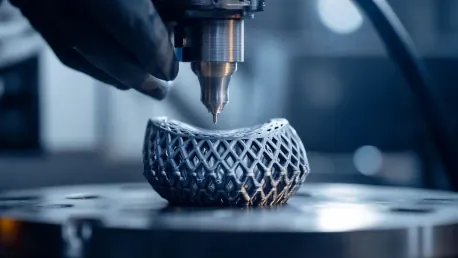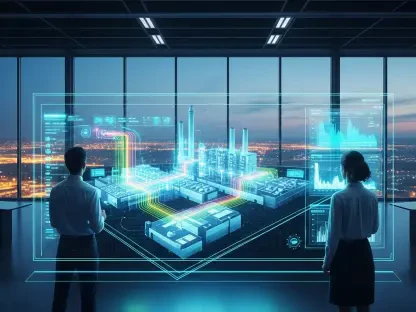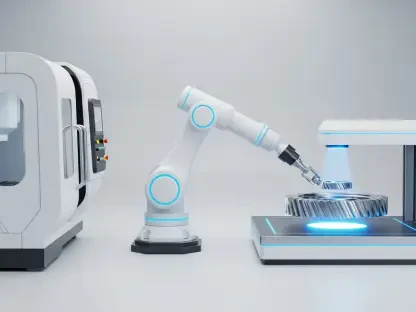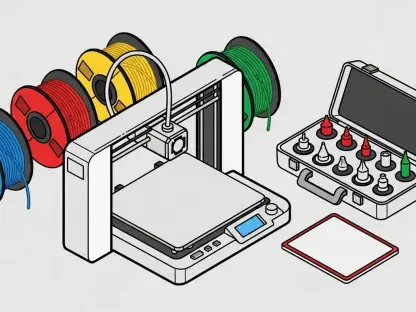The Additive Manufacturing (AM) industry has experienced a tumultuous year in 2024, marked by financial volatility, strategic consolidations, and emerging trends. The landscape has become increasingly complex as key players navigate a slew of challenges while seeking growth opportunities. This article delves into the intricate dynamics shaping the sector, providing a comprehensive analysis of the key factors influencing its trajectory.
Financial Stress in the AM Industry
Persistent Financial Strain
Despite a slight uptick in attendance figures at the Formnext event, financial stress remains a significant challenge across the AM industry. The presence of empty spaces and notable absentees, such as OEM Nexa3D, suggests companies are adopting more conservative financial strategies. This belt-tightening reflects deeper restructuring efforts undertaken by various companies to stay afloat. For instance, Oerlikon AM has honed its focus on the United States market, while Desktop Metal has resorted to strategic partnerships aimed at cost reduction. These moves underscore a common theme: the sustained financial pressure is compelling companies to innovate operational practices and explore new market avenues.
Companies that have struggled to maintain financial viability serve as cautionary examples. Apiumtec and Forward AM have ceased operations, while Zeda Technologies Inc.’s Aerospace and Defense division and Velo3D are grappling with significant financial pressures. The sector simultaneously sees the entrance of new players, creating a dual narrative where the industry’s evolution is marked by both contraction and expansion. This juxtaposition of companies shutting down and others emerging highlights the inherent volatility and dynamic nature of the AM sector. Firms finding themselves in precarious positions must reinvent themselves or risk being overshadowed by more agile and financially stable competitors.
Impact on Companies
The industry’s financial strain has led to varied responses among different companies. While some firms have shuttered operations, others are adopting creative solutions to mitigate economic pressures. For instance, the focus of Oerlikon AM on the U.S. market indicates a strategic reevaluation aimed at capitalizing on areas with the highest growth potential. Similarly, Desktop Metal’s partnerships underscore the importance of collaboration in navigating financial constraints. These strategies reflect a broader industry trend toward efficiency and market-specific engagements to remain competitive in a tightening fiscal environment.
Despite these challenges, the AM industry remains fertile ground for innovation and new market entrants. Even as well-established names grapple with financial issues, new companies are stepping in, introducing novel technologies and solutions. This ebb and flow of companies highlight the resilience and adaptability inherent in the AM sector. New market participants bring fresh perspectives, driving innovation while older firms that manage to weather the storm often emerge stronger and more focused. Together, these dynamics illustrate a complex but intriguing landscape where financial volatility catalyzes both challenges and opportunities.
Company Dynamics and Acquisitions
Strategic Consolidations
Acquisitions have emerged as a hallmark of the AM industry’s evolution, driven more by the quest for financial stability than by mere market positioning. In 2024, the sector witnessed fewer acquisitions compared to previous years, but these were strategically impactful. Siemens’ acquisition of Altair, Nano Dimension acquiring Markforged, and Anzu Partners’ purchase of Voxeljet AG stand out as critical moves influencing the industry’s future. Each acquisition brought together complementary skills and technologies, suggesting a trend toward consolidating capabilities to enhance competitiveness and financial resilience in a challenging market.
Conversely, Sandvik’s decision to exit its stake in BEAMIT highlights the varied strategic responses to current market conditions. While some companies are doubling down on their investments, others are opting to streamline their portfolios, shedding ventures that may no longer align with their core strategies. This diversified approach to acquisitions and divestments underscores the complexity of the AM market. Financial and strategic motives intersect, shaping an industry landscape where adaptability and forward-thinking strategies become essential traits for survival and success.
Varied Strategic Responses
The AM industry’s varied strategic responses to financial strain highlight how companies navigate economic volatility while seeking sustainable growth pathways. Siemens, for example, saw value in acquiring Altair to bolster its technological capabilities and global market presence. Similarly, Nano Dimension’s purchase of Markforged aimed to expand its product portfolio and market reach, reflecting a forward-thinking approach to capitalizing on emerging opportunities. These acquisitions underscore the importance of strategic alignment in driving long-term success, even amidst financial uncertainties.
On the other hand, Sandvik’s exit from BEAMIT illustrates a more cautious approach emphasizing focus and efficiency over expansion. By divesting from non-core assets, Sandvik aims to concentrate resources on core areas, enhancing operational efficiency and stability. This varied strategic landscape indicates that there is no one-size-fits-all approach in the AM industry. Companies must continually assess their strengths, market conditions, and growth objectives to tailor their strategies accordingly. This dynamic environment fosters a resilient industry capable of adapting to economic fluctuations while pursuing innovation and market leadership.
Application-Centric Growth
Shift Towards Specific Applications
A significant trend in the AM industry is the shift towards emphasizing specific applications of 3D printers rather than general capabilities. This change reflects a growing understanding that applications drive development in a virtuous cycle—more designs foster more applications, which in turn spur material and printer innovations. By focusing on application-centric growth, companies can better meet the specific needs of various industries, tailoring solutions to solve particular problems and enhancing their value proposition. This trend marks a critical evolution in the industry’s maturation, moving from a one-size-fits-all approach to a more targeted and customized strategy.
The move towards specific applications is fueled by the need to showcase the tangible benefits of 3D printing technology. Companies are increasingly highlighting case studies and success stories that demonstrate the practical advantages of their solutions in real-world scenarios. This approach helps to build credibility and trust among potential customers, who may be more willing to invest in 3D printing technology when they see its proven effectiveness in similar applications. As more designs and applications emerge, the industry is likely to see continued innovation in materials and printer technologies, further driving growth and adoption across various sectors.
Customization and Innovation
The focus on application-centric growth significantly boosts customization and innovation within the AM industry. Tailored solutions enable companies to address specific market demands, leading to the development of custom materials, printers, and processes designed to optimize performance for particular applications. This customization enhances competitive differentiation, allowing companies to carve out niche markets and serve them with highly specialized products and services. As a result, businesses can deliver greater value to their customers, driving higher adoption rates and fostering long-term relationships.
Moreover, the strategic emphasis on application-centric growth promotes a culture of continuous innovation. Companies are incentivized to explore new frontiers in 3D printing technology, seeking ways to enhance efficiency, reduce costs, and improve overall performance. This innovative environment encourages collaboration among industry players, academic institutions, and research organizations, leading to groundbreaking advancements and the creation of new market opportunities. The combined forces of customization and innovation underscore the AM industry’s potential to revolutionize various sectors, driving progress and addressing complex challenges in ways that were previously unimaginable.
Defense Sector Growth
Geopolitical Tensions and Investment
Geopolitical tensions, such as Russia’s invasion of Ukraine, have driven renewed investments in advanced technologies, including additive manufacturing. The defense sector, in particular, has emerged as a substantial driver of AM technology advancements. Defense budgets, especially in the United States, are allocating significant funds toward the development of cutting-edge technologies. The U.S. Department of Defense budget for fiscal 2025, for instance, underscores this trend, anticipating advancements in unmanned systems and the space economy, all of which are expected to leverage AM technologies extensively.
This heightened focus on defense applications of AM is not limited to the United States. The European Union’s European Defence Fund also highlights collaborative efforts in defense research and development, seeking to enhance AM’s role in future military capabilities. The increased investment in AM technologies for defense purposes is transforming the industry, driving innovation and pushing the boundaries of what’s possible. By focusing on defense applications, AM companies can tap into substantial funding and resources, spurring further advancements and expanding their technological capabilities.
Collaborative Efforts and R&D
In response to geopolitical tensions and the growing importance of advanced technological capabilities, collaborative efforts and research and development (R&D) have become pivotal in the defense sector’s adoption of AM. The European Union’s European Defence Fund exemplifies this trend, emphasizing collaboration among member states to develop cutting-edge defense technologies. These collaborative efforts not only pool resources and expertise but also accelerate innovation and technological breakthroughs. By working together, countries and companies can develop more sophisticated AM solutions tailored to meet the specific needs and challenges of modern defense operations.
The focus on R&D is driving remarkable advancements in AM technology, particularly in materials science and manufacturing processes. Innovations in lightweight, durable materials, for instance, are crucial for developing advanced defense systems such as unmanned aerial vehicles and next-generation combat equipment. Additionally, the integration of AM with other emerging technologies, such as artificial intelligence and digital twinning, is pushing the envelope of what’s possible in defense applications. These advancements are poised to revolutionize the defense sector, making military operations more efficient, effective, and adaptable to evolving threats.
Emerging Asian AM Companies
Rise of Asian Players
The rise of Asian AM companies marks a significant shift in the industry’s global dynamics, reflecting the increasing influence of this region on the global market. Countries like China, Japan, and South Korea are becoming pivotal players in the AM sector, driven by substantial government investments, an expanding talent pool, and a strong focus on innovation. This growth is reshaping market dynamics by introducing new competition and sparking technological advancements that push the industry forward. The expansion of Asian AM companies is not simply an increase in the number of market participants but also highlights the qualitative leaps in technological capabilities they bring to the table.
This burgeoning influence is exemplified by the rapid advancements and market penetration of Chinese companies, which are introducing cost-effective solutions and cutting-edge technologies. Japanese firms are known for their precision engineering and high-quality manufacturing standards, contributing significantly to the technological ecosystem of AM. South Korean enterprises, on the other hand, are incorporating advanced materials and smart manufacturing systems to stay competitive. These developments not only enhance the global AM landscape but also set the stage for increased collaboration and competition across continents, enriching the overall industry.
Impact on Global Market
The growing presence of Asian AM companies is transforming the global market by introducing new dynamics and accelerating innovation. These firms bring fresh perspectives and technological innovations that challenge established players and compel the industry to continuously evolve. The competition introduced by Asian companies drives down costs, making AM technology more accessible to a broader range of industries and applications. This increasing accessibility fosters greater adoption and integration of AM solutions across various sectors, including aerospace, automotive, healthcare, and consumer goods.
Furthermore, the influence of Asian AM companies extends beyond their immediate technological contributions. Their focus on scalable, cost-effective manufacturing solutions has set new standards for efficiency and productivity within the industry. This emphasis on scalability and affordability is crucial for driving widespread adoption of AM technologies, particularly in regions and markets that have traditionally been slower to embrace these advancements. As a result, the global AM landscape is becoming more dynamic and interconnected, with Asian companies playing a crucial role in shaping the future of the industry.
Uncertainty and Future Outlook
Resilience Amidst Ambiguity
Despite the prevailing uncertainty in the global economy, some companies, particularly those with vertically integrated business models, have demonstrated considerable resilience. Entities like Domin and Conflux Technology exemplify how strategic structuring can provide a buffer against economic turbulence. These companies have strengthened their market positions by focusing on core competencies and leveraging integrated supply chains, enabling them to navigate financial constraints more effectively. This resilience amidst ambiguity paints a nuanced picture of the AM landscape, suggesting that opportunities exist even in challenging conditions for those well-positioned to seize them.
Vertically integrated companies benefit from greater control over their production processes, reduced dependency on external suppliers, and the ability to swiftly adapt to market changes. This strategic advantage is particularly valuable in times of economic uncertainty, allowing businesses to maintain operational efficiency and meet customer demands. The success of these companies demonstrates that a well-thought-out business model can mitigate financial stress and create a stable foundation for growth. By focusing on innovation, diversification, and strategic partnerships, vertically integrated firms are well-equipped to thrive in an ever-evolving market.
Strategic Structuring
In 2024, the Additive Manufacturing (AM) industry has faced a year of significant upheaval, characterized by financial instability, strategic mergers, and new trends. As major players maneuver through a maze of challenges, they are also on the lookout for growth opportunities. This period has seen the sector become more intricate and multifaceted. The evolving landscape requires companies to be agile and innovative to maintain their competitive edge. This article offers a detailed examination of the complex dynamics shaping the industry, providing an in-depth analysis of the critical factors that are set to influence its future direction. A closer look reveals how financial fluctuations are impacting investment and operations, while strategic consolidations are redefining market positions. Additionally, emerging trends in technology and materials are opening new avenues for innovation and application, reflecting a period of both potential and peril for firms within the AM sector. Through this comprehensive analysis, we gain insights into not just the current state, but the future prospects of the industry.









